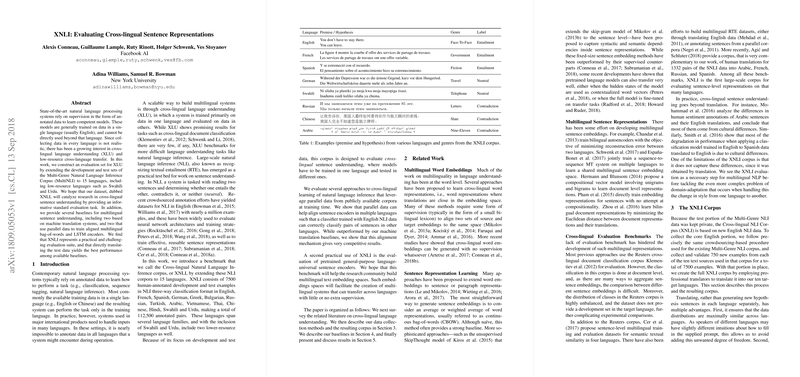Analyzing the XNLI Benchmark for Cross-lingual Sentence Representations
The paper "XNLI: Evaluating Cross-lingual Sentence Representations" presents a comprehensive evaluation benchmark for cross-lingual language understanding (XLU) by extending the Multi-Genre Natural Language Inference Corpus (MultiNLI) to 15 languages, including low-resource languages like Swahili and Urdu. This essay provides a detailed examination of the methodologies, numerical results, and implications of this work within the field of NLP.
Core Contributions
The primary contributions of the paper are twofold. First, it introduces the Cross-lingual Natural Language Inference (XNLI) corpus, which consists of 7500 development and test examples across 15 diverse languages, translated from English. Second, it reports on several baseline methodologies for the XNLI task, including those based on machine translation (MT) and multilingual sentence encoders.
Methodological Overview
Data Collection and Translation
The XNLI corpus was constructed by recruiting professional translators to extend the English MultiNLI dataset. This method ensured that the semantic relationships between the sentence pairs were preserved across languages. The data were carefully validated to maintain the integrity of the translation and to mitigate semantic drift.
Baseline Models
The paper evaluates multiple baseline approaches:
- Machine Translation Baselines: These include "translate train," which translates the training data to each target language, and "translate test," which translates the test data to the training language.
- Multilingual Sentence Encoders: Two types were evaluated:
- X-CBOW: A transfer learning approach where CBOW representations are aligned using the parallel data.
- X-BiLSTM: Bidirectional LSTM encoders trained on MultiNLI and aligned using parallel corpora, with separate training paradigms extracting features using either the final hidden state or the element-wise max over all hidden states.
Numerical Results and Analysis
The results indicate that while machine translation baselines generally yielded superior performance, the multilingual sentence encoders offered competitive results. Specifically:
- Translate Test: Achieved the highest accuracies with notable instances like French (70.4%) and Spanish (70.7%) against the English baseline (73.7%).
- X-BiLSTM-Max: Outperformed X-CBOW and showed promising performance with results like 67.7% for French, indicating effective cross-lingual sentence representation alignment.
The alignment loss employed in X-BiLSTM models demonstrated a clear correlation with performance, as illustrated in the training evolution plots. This alignment mechanism proved essential in mapping the sentence representations into a common embedding space, thereby facilitating cross-lingual NLI tasks.
Implications and Future Directions
The introduction of XNLI represents a significant step forward in standardizing the evaluation of cross-lingual sentence understanding. The corpus's inclusion of both high-resource and low-resource languages broadens the scope of practical applications for multilingual systems. By highlighting the efficacy and limitations of different baseline models, the paper establishes a foundation for future research in XLU.
The results suggest several avenues for further paper:
- Enhancement of Alignment Mechanisms: Investigating joint training of encoders or alternative parameter-sharing strategies can improve the alignment of sentence embedding spaces.
- Exploration of Alternative Architectures: Considering attention mechanisms or pre-trained LLMs like BERT or GPT for multilingual embeddings can enhance performance further.
- Expanding Low-resource Language Support: Increasing the volume of parallel data and exploring unsupervised or semi-supervised learning methods can aid in improving representation quality for low-resource languages.
Conclusion
The XNLI benchmark sets a new standard for evaluating cross-lingual sentence representations, emphasizing the robustness required of NLP systems in multilingual environments. The inclusion of diverse languages and thorough evaluation of several baseline models offer a solid groundwork for advancing research in cross-lingual language understanding, thereby pushing the boundaries of multilingual NLP capabilities. As AI research continues to progress, the insights and results derived from XNLI will undoubtedly play a critical role in shaping the development of more inclusive and efficient natural language processing systems.
